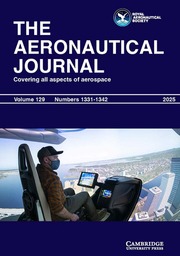No CrossRef data available.
Article contents
Investigating the efficacy of baseline wind turbine controllers against ice accumulation on rotor blades
Published online by Cambridge University Press: 10 September 2025
Abstract
Blade ice accumulation is a serious problem that changes turbine aerodynamics and dynamics, leading to lower power output and higher structural loading. Different from the literature, this paper investigates the performance effectiveness of baseline wind turbine controllers: the generator torque and collective blade pitch controllers against rotor blade ice accumulation. The NREL 5-MW turbine is utilised, and simulations of baseline controllers are conducted with the MS (Mustafa Sahin) Bladed Model for clean and iced blade cases. The performance of the controllers is examined in below (Region 2) and above (Region 3) rated regions under 1 m/s step rising wind speeds. Results are presented through various parameters, including turbine controllers’ gain(s), blade pitch angle, rotor speed, power, etc. Rotor speed response is used to evaluate the controllers’ performance. Even slight blade ice accumulation is estimated to affect turbine efficiency and characteristics, decreasing  ${C_{pmax}}$ by 13.27%, slightly varying optimum blade pitch angle and tip speed ratio, altering the control input gain by up to 14.68%. Blade ice accumulation is observed to adversely affect baseline controllers’ performance. In Region 2, the torque controller exhibits reduced transient and steady-state performance, with rotor speed reaching the steady-state approximately 2 s later and showing a steady-state error of 1.86%. In Region 3, the pitch controller’s transient performance deteriorates at low wind speeds, particularly near the rated wind speed, leading to an increased decay time of up to 5.2 s. However, beyond 16 m/s, pitch controller performance gradually recovers, becoming nearly identical to the clean blade case at 21 m/s, while the controller steady-state performance remains unaffected.
${C_{pmax}}$ by 13.27%, slightly varying optimum blade pitch angle and tip speed ratio, altering the control input gain by up to 14.68%. Blade ice accumulation is observed to adversely affect baseline controllers’ performance. In Region 2, the torque controller exhibits reduced transient and steady-state performance, with rotor speed reaching the steady-state approximately 2 s later and showing a steady-state error of 1.86%. In Region 3, the pitch controller’s transient performance deteriorates at low wind speeds, particularly near the rated wind speed, leading to an increased decay time of up to 5.2 s. However, beyond 16 m/s, pitch controller performance gradually recovers, becoming nearly identical to the clean blade case at 21 m/s, while the controller steady-state performance remains unaffected.
Keywords
Information
- Type
- Research Article
- Information
- Copyright
- © The Author(s), 2025. Published by Cambridge University Press on behalf of Royal Aeronautical Society


